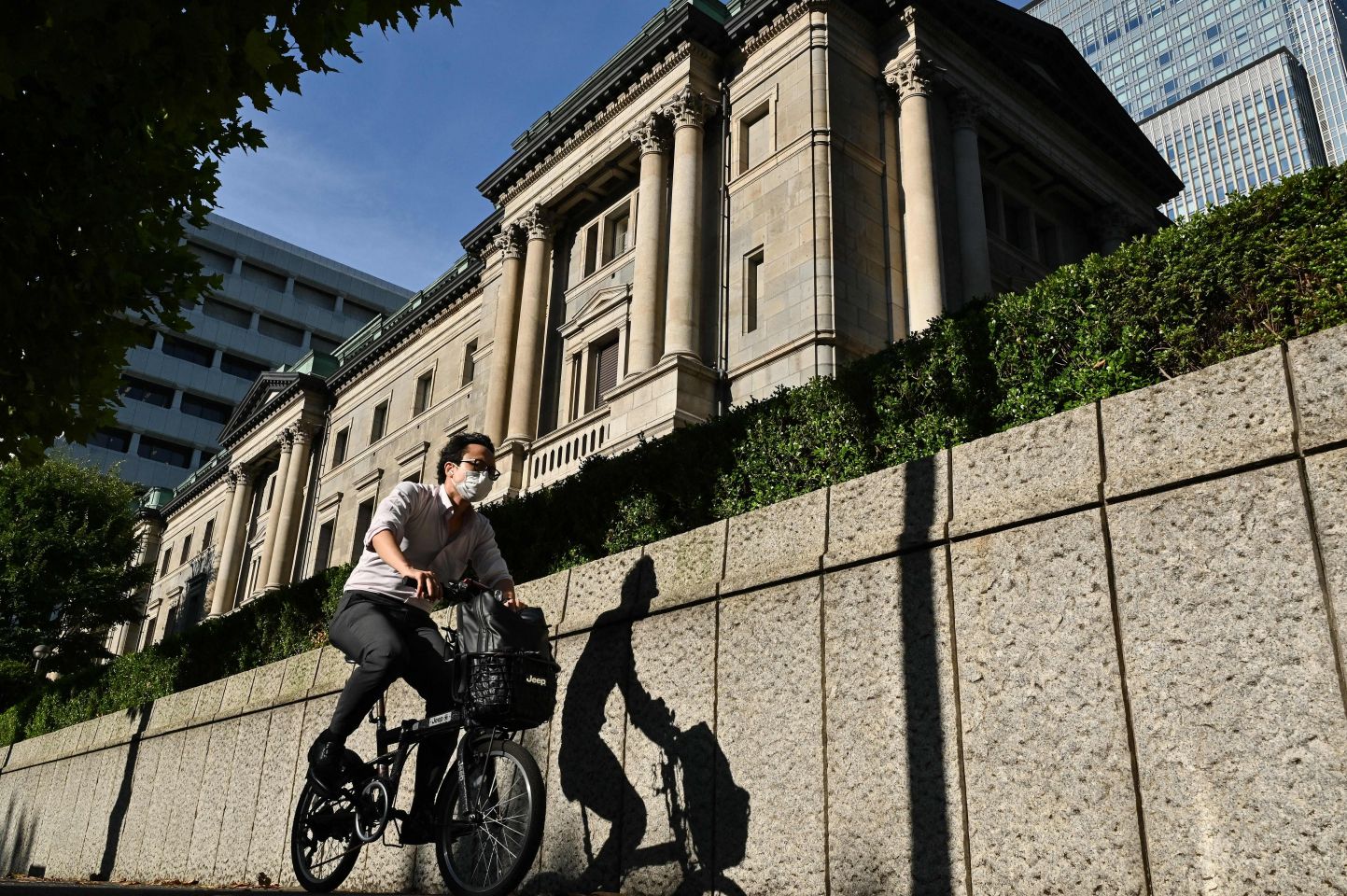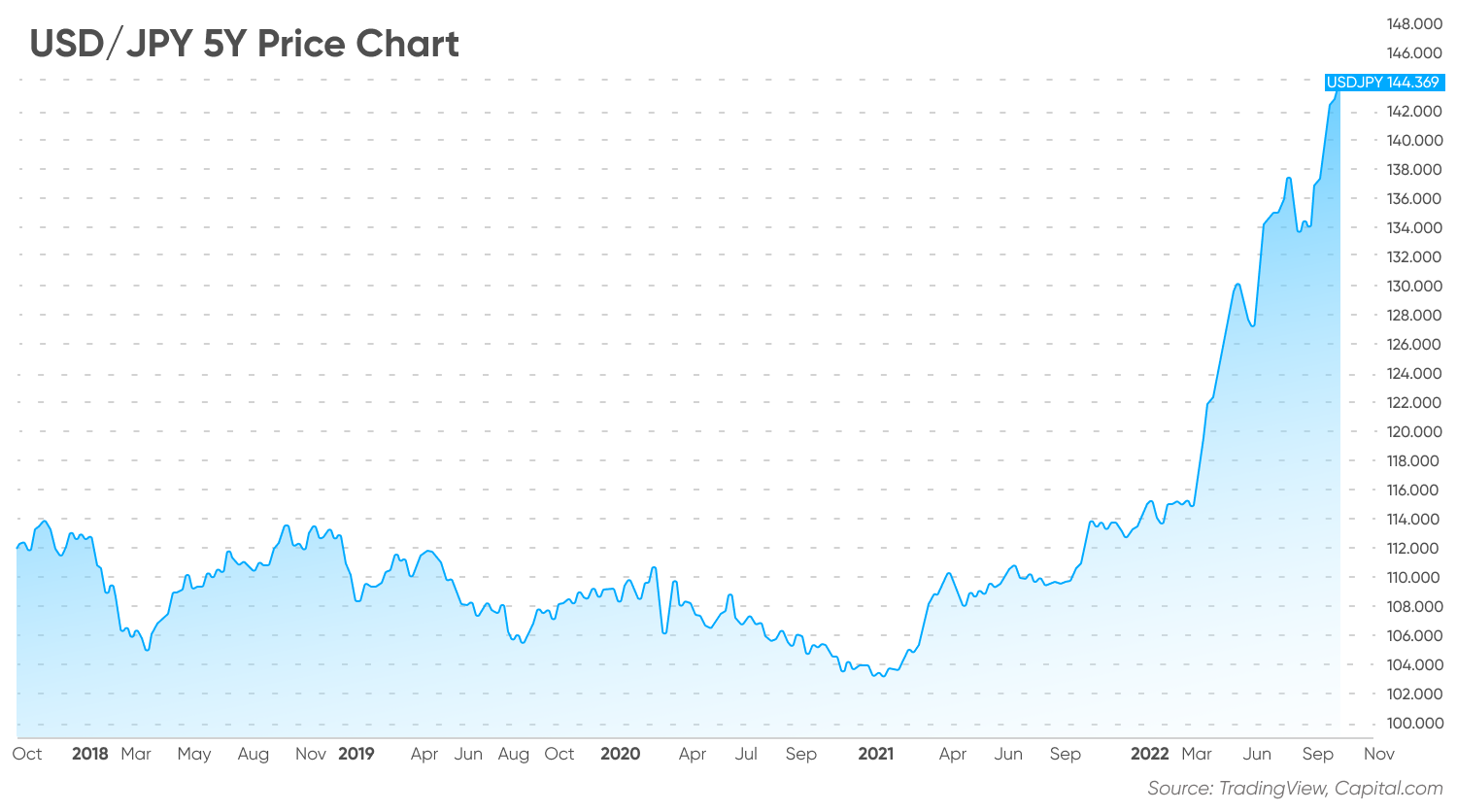Projected Japan interest rate in 5 years: Can BoJ hold its nerve and maintain low rates?
The Bank of Japan is unlikely to raise its policy rate despite rising inflation and a weaker yen. Read on for the latest overview of the projected Japan interest rate in 5 years.
The Bank of Japan (BoJ), Japan’s central bank, has remained steadfast with its ultralow interest rate rate policy despite the yen’s (JPY) sharp depreciation.
In a monetary policy meeting on 10 March, the Bank of Japan’s interest rate was left unchanged at -0.1%, making the BoJ the only G10 central bank that maintained a dovish stance in a global monetary tightening cycle. The BoJ also kept the 10-year Japanese Government Bond (JGB) at a level of 0%.
The US dollar (USD) to Japanese yen exchange rate briefly crossed the resistance level of 145.33, the lowest since 1998, and as of 10 March it was at 134.98.
The yen's depreciation has reflected the growing gap between Japanese interest rates and the US policy rate. The US Federal Reserve (Fed) raised its federal funds rate by 25bps to 4.5%-4.75% in its February 2023 meeting.
The risk of further yen depreciation looms as analysts expect the Fed will continue its rate hike policy into 2023, while inflation was expected to accelerate. Will the Bank of Japan end its dovish stance?
In this article, we look at the BoJ’s policy rate history and drivers for the central bank’s monetary approach, as well as analysts’ opinions on the projected Japan interest rate in 5 years.
What is the Bank of Japan?
Established in 1882 by the Bank of Japan Act, the Bank of Japan (BOJ) is the country’s central bank.
The Act was amended several times, including in June 1949 with the establishment of the Policy Board, the bank’s highest decision-making body. The board decides monetary policy and the bank’s business operations.
The Policy Board has two types of meetings: Monetary Policy Meetings (MPMs) and regular meetings.
The MPM looks at matters related to monetary policy eight times a year. It adjusts guidelines for money market operations and the basic discount rate, the basic loan rate and reserve requirement ratios. The board meets twice a year to discuss non-monetary policy matters.
One of the BoJ’s monetary policy objectives is price stability, with a target of keeping the Consumer Price Index (CPI) to a maximum increase of 2% year-over-year (YoY).
The Policy Board’s nine members – the Governor, two Deputy Governors and six other members – are appointed by the Cabinet, subject to the consent of both houses of the Diet (Japan’s parliament), the House of Representatives and the House of Councillors.
Japan’s interest rate history
Japanese interest rates averaged 2.34% from 1972 to 2023, reaching an all-time high of 9% in December 1973 and a record low of -0.10% in January 2016, according to economic data provider TradingEconomics.
Japan’s central bank began its policy of low interest rates in 1995 by cutting the key rate to 0.50% in September 1995 from 1% in April 1995, according to Japan interest rate history data from the BoJ.
During the global financial crisis of 2007-2008, the BoJ gradually reduced its policy rate to 0.10% by December 2008, from 0.50% in February 2007. The rate cut came as the country’s exports decreased due to a slowdown in overseas economies. On the domestic front, demand was weak as corporate profits and employment fell as household incomes worsened, the central bank said in its statement.
The Bank of Japan’s interest rate remained at between 0% to 0.10% until January 2016, when it cut the rate to -0.10% as the country’s economic recovery came in at a moderate pace and was coupled with weak inflation.
The bank raised concerns about the UK's referendum to leave the European Union, blaming the country for causing instability in global markets, and announcing an expansion of its monetary easing programme.
“Against the backdrop of the United Kingdom’s vote to leave the European Union and the slowdown in emerging economies, uncertainties surrounding overseas economies have increased and volatile developments have continued in global financial markets,” the BoJ said in a statement on 29 July 2016.
Since 2016, the bank has kept its policy rate unchanged at -0.1%.
Japan’s growth revised but acceleration from 2022 possible
Organisation for Economic Co-operation and Development (OECD) has projected that Japan's GDP growth could be at 1.8% in 2023 and 0.9% in 2024.
The (OECD) wrote in a note:
The Government of Japan estimated in December that GDP is expected to expand 1.5% in the fiscal year beginning in April 2023.
However, in the latter part of 2022, Japan's economy narrowly avoided entering into a recession, after GDP expanded by an annualised 0.1% in October - December.
Private consumption, which makes up more than half of the country's GDP, grew 0.3%, acording to government data and was downgraded from an initial estimate of a 0.5% increase.
Wakaba Kobayashi, economist at Daiwa Institute of Research said:
The median forecast by the majority of Monetary Policy Board members saw Japan’s GDP growing in fiscal year 2023 to 1.7% and 1.1% in 2024, according to BoJ’s quarterly Outlook for Economic Activity and Prices, released in January 2023.
The BoJ said in a report:
According to BofA, there are tailwinds that could ensure that Japan will continue its solid growth. These include recovery in auto production, which suffered from semiconductor shortages, and an increase in foreign tourist arrivals in line with borders reopening.
On the other hand, BofA also warned of slowing manufacturing as the US, one of Japan’s main trading partners, is forecast to go into recession. Risks from inflation may serve as strains on Japan’s economic recovery.
Netherlands-based ING Group forecast the country’s GDP to grow by 1.2% in 2023.
Fitch Ratings forecast Japan's GDP to grow 1.3% in 2023, down from 1.5% and 1.1% in 2024.
The firm wrote on 21 February
Risks of rising inflation
In the latest Japan interest rate news, the annual inflation rate in Japan rose to 4.3% in January 2023 from 4.0% in the prior month. This was the highest reading since December 1981, amid a rise in prices of imported raw commodities and yen weakness, according to data from Trading Economics.
Electricity and gas for households registered the biggest jump of 21.5% and 20.1%, respectively. Japan is a net importer of oil and natural gas, whose prices have hit record highs amid Russia’s invasion of Ukraine.
Food prices in Japan rose by 7.3% yoy in January 2023.
The BoJ said in its January 2023 statement:
BofA forecast Japan’s CPI to average 1.6% in 2023 and 1.3% in 2024.
ING projected Japan’s inflation to average 1.6% in 2023 and 1.1% in 2024.
Fitch Ratings expected inflation in Japan to reach 1.3% in 2023 and 1.1% in 2024.
Weakening USD/JPY – time to raise the rate?
The dollar/yen pair (USD/JPY) breached 150 in October 2022, marking a 32-year low. This was caused by Japan's trade deficit and the BoJ dovish stance. The yen closed out 2022 almost 18% down versus the USD, but analysts expect it to strengthen in 2023.
Benjamin Shatil, Head of Japan FX Research at J.P. Morgan said:

As of 14 March, the pair was trading around the 134 level.
Some analysts, are doubtful that the yen can strengthen.
John Bradley, head of foreign exchange at BNP Paribas Asset management said in March:
Fitch Ratings has forecast yen to appreciate sliglity aganist the dollar in 2023 to 130JPY/USD . The firm commented in March 2023:
BofA expected the USD/JPY to average 127 by December 2022 and 120 by June 2023, remaining at that level until December 2023. The currency pair was expected to hit 121 and 124 by March and June 2024, respectively.
The BofA still expects overall yields will continue to undermine the yen in 2023.
ING predicted the USD/JPY to drop to 130 in Q1 2023, average 125 in Q4 2023, and ease to 120 in Q4 2024.
Japan’s interest rate outlook for 2023 and beyond
As the yen continues to depreciate, and the inflation rate is expected to accelerate in the coming months, what are analysts’ forecasts for Japan's interest rate in 5 years?
The BoJ has projected in January that long-term rates could rise from 0.3% seen this fiscal year, to 0.4% in 2023-2025, before climbing eventually to 3.1% in fiscal 2032. The projections show that a 0.5 percentage-point rise in long-term rates would add 3.3 percentage points to the debt-to-GDP ratio.
Fitch Ratings and ING expected the Bank of Japan interest rate would remain unchanged at -0.1% until the end of 2024.
BofA expected the Bank of Japan to hold the ultra-loose policy rate through the remainder of Governor Haruhiko Kuroda’s tenure, and any policy normalisation would be delayed until new leadership came in after April 2023, despite pressure from the weaker yen.
In a note, CIBC Capital Markets said that it also did not expect the BoJ to reverse its ultra-low rates until Kuroda's successor takes office after Q1 2023.
Analysts did not provide a Japanese interest rate forecast beyond 2024 due to uncertainty after BoJ’s leadership change the following year.
The bottom line
Analysts quoted in this article were all in the opinion that the BoJ was unlikely to abandon or adjust its ultra-loose policy rate until Governor Kuroda’s tenure ends in Q1 2023.
Keep in mind that analysts' opinions and forecasts can often be wrong. Forecasts should not be used in place of your own research. Always conduct your own due diligence before trading or investing. And never invest or trade money that you cannot afford to lose
FAQ
Will the Bank of Japan increase interest rates?
Analysts believe the Bank of Japan is unlikely to increase its ultra-loose policy rate until Governor Kuroda's term expires in the first quarter of 2023. However, analysts are often wrong in their projections and forecasts. Remember to always do your own research.
How long has Japan had 0% interest rates?
Japan has kept interest rates at 0% since the global financial crisis in 2008.
What is Japan's current interest rate?
Japan’s current interest rate is -0.10% which has been in place since January 2016.